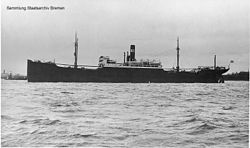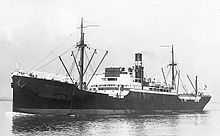Ockenfels (ship, 1910)
|
The second Ockenfels
|
||||||||||||||||||||||||
|
||||||||||||||||||||||||
|
||||||||||||||||||||||||
|
||||||||||||||||||||||||
|
||||||||||||||||||||||||
The second Ockenfels of the Deutsche Dampfschiffahrtsgesellschaft Hansa (DDG "Hansa"), which came into service in 1910, was the type of a series of eight cargo ships that were built from 1910 to 1913 at the German shipyards of Joh. C. Tecklenborg and AG Weser .
Because of the outbreak of the First World War , the Ockenfels was launched in Boston in 1914 . Confiscated by the USA in 1917 and used as a transport, it was renamed the USS Pequot in 1918. Initially chartered, the DDG "Hansa" bought the ship back on June 28, 1923 and operated it as Argenfels until 1932 .
History of the ship
The eight ships of the Ockenfels class of the DDG “Hansa” followed the eight ships of the Rheinfels class on the main routes to the Indian Ocean , which were delivered to the shipping company from 1905 to 1907, but four of which were still being built in Great Britain while the new ones Ships for the first time all were built in Germany. The Ockenfels was built in 1910 by two sisters from the Tecklenborg shipyard, which had already delivered a similar ship of the Rheinfels class in 1906 with the first Rotenfels , but also ships of the smaller Warturm before the first three and the fourth ship of the Ockenfels class -Class delivered to the DDG "Hansa".
The name of Castle Ockenfels near Linz on the Rhine was first given in 1895 to a steamship of 3589 GRT built by Dixon for the East India service. It sank on July 3, 1909 as the shipping company's last pre-war loss while leaving Gibraltar after a collision with the British steamer Duart (1901, 3108 GRT).
The new Ockenfels of 5684 GRT was the type ship of the series comprising eight newbuildings. It was launched on April 9, 1910 and was delivered on May 28, 1910. Like the four sister ships supplied by Tecklenborg, the ship had a length of 138.68 m over all, a width of 16.83 m and a draft of 7.63 m. The four-cylinder, four-fold expansion engine of 2500 HP supplied by the shipyard enabled the ship to travel at 11 knots (kn). The new building had a carrying capacity of 8976 tdw and was operated with a crew of 63 men, with the majority of the machine personnel being recruited in India. The first two sister ships followed in 1910 into service. In 1912 AG Weser delivered its first building in this series and the Tecklenborg shipyard a fourth new building. The series was completed in 1913 with three more new buildings from AG Weser. This series was followed by the ships of the Rappenfels class from 1913 as the last pre-war series .
Mission history
The Ockenfels came into service with the Bremen shipping company with the first two sister ships in 1910. None of the eight ships were at home when the war broke out in 1914, three were immediately confiscated by the British, and three more came into service with the Entente when the countries of refuge entered the war . Only the Kandelfels and Huberfels remained without a war effort, as they could not leave Antwerp because of the neutrality of the Netherlands.
War effort
The Ockenfels remained in Boston when the war broke out in 1914. The express steamer Kronprinzessin Cecilie (19,501 GRT), the Köln , Wittekind and Willehad of Norddeutscher Lloyd as well as the passenger steamers Cincinnati (16,339 GRT) and America of Hapag also found refuge there.
When the USA entered the war, around 100 German ships were confiscated in the American sphere of influence and used for war operations. In addition to the Ockenfels , this also included the Hansa ships Adamsturm in New York , Liebenfels in Charleston (South Carolina) and OJD Ahlers in Honolulu .
As with most of the German ships, the crew on the Ockenfels had made the machine unusable. After necessary repairs, the ship did not enter service until October 28, 1918 as the USS Pequot (ID-2998). Armed with a 127 mm and a 76 mm gun, the cargo ship was used by the US Navy until July 11, 1919.
Again under the German flag
In 1923 the “California Steamship” Co. in Panama acquired the Pequot ex Ockenfels from the US Shipping Board , but chartered it to the DDG “Hansa”, which acquired its former ship on June 28, 1923 and took it over in Cardiff. The ship was given the name Argenfels because the original name had already been reassigned when the third Ockenfels of the Frauenfels class was launched on July 28, 1921 .
Named after Arenfels Castle near Hönningen on the Rhine, the first Argenfels was commissioned by DDG “Hansa” in 1901. In 1914 it was confiscated by the French in Saigon . The 5654 GRT ship, built by Wigham Richardson & Co , was sold to Greece in 1921 and served there as Demetrios Diacakis , then Dimitrios M. Diacakis until it was demolished in 1932.
The second Argenfels ex Ockenfels remained in the service of DDG Hansa for nine years without any modifications before it was sold to Blohm & Voss in Hamburg for demolition on December 24, 1932 as part of the reduction in the fleet during the global economic crisis .
After its demolition, four ships of the class were still in service worldwide. Two of them were lost in World War II; the last two ships were abandoned in 1950 and 1958, respectively.
The ships of the Ockenfels- class
| Surname | Shipyard | GRT tdw |
Launched in service |
further fate |
|
Ockenfels (2) |
Tecklenborg building no. 235 |
5684 8976 |
April 9, 1910 May 28, 1910 |
Laid up in Boston in 1914 , confiscated in 1917 and used as a USN transporter, renamed USS Pequot in 1918, June 28, 1923 repurchase by DDG "Hansa": renamed Argenfels , 1932 for demolition |
|
Birkenfels (1) |
Tecklenborg building no. 236 |
5639 8150 |
June 7, 1910 July 23, 1910 |
Confiscated in Cape Town in 1914 : Tandem , Polshannon in 1915 , Pinna in 1921 , converted into a tanker in 1922 (6121 BRT, 8150 tdw), sunk on February 4, 1942 after attacks by Japanese planes |
|
Freienfels (1) |
Tecklenborg building no. 237 |
5633 8705 |
20.09.1910 11.22.1910 |
Confiscated in Calcutta in 1914 , used as a transporter, 1925 sold to Greece: Hadiotis , 1928 to Italy: Felce , confiscated in Haifa in 1940 : Empire Defender , sunk off Tunisia by Italian torpedo planes on November 15, 1941 |
|
Storm Rock (1) |
Tecklenborg building no. 249 |
5660 8700 |
September 14, 1912 November 5, 1912 |
August 1914 in Massaua , confiscated in 1915, as Ferrara under the Italian flag, 1920 in Luigi Rizzo , 1924 in Nazareno , 1926 renamed in Gerarchia , interned in Cape Verde from 1940 to 1944, 1947 Rosolino Pilo , then Giuseppe Mazini , 1956 to Panama: Mizar , 1958 demolished in Japan |
|
Kandelfels (1) |
AG Weser Building No. 185 |
5739 8668 |
04/27/1912 07/10/1912 |
Blocked in Antwerp in August 1914 , extradited to Great Britain by the Netherlands / Belgium in 1919, renamed Kirkstall Abbey in 1920 , to Vereenigde Nederlandsche Scheepvaartmaatschappij (VNS) in 1921 : Koudekerk , Italian Laura Lauro in 1931 , Brazilian cearaloids in 1941 , returned to Italy in 1949, canceled in 1950 |
|
Huberfels (1) |
AG Weser Building No. 191 |
5814 8960 |
21.12.1912 31.01.1913 |
Blocked in Antwerp in August 1914, extradited to Great Britain by the Netherlands in 1919, renamed Bolton Abbey in 1920 , to VNS in 1921: Bovenkerk , canceled in 1932 |
|
Lauterfels (1) |
AG Weser Building No. 193 |
5811 8930 |
1913 March 27, 1913 |
Confiscated in Port Said August 1914 : Hungerfjord , sunk by UC 75 off Bristol 16 April 1918 |
| Spitzfels (1) | AG Weser Building No. 194 |
5809 8930 |
May 16, 1913 June 16, 1913 |
Confiscated August 1914 in Cagliari , 1915 as Brescia under the Italian flag, renamed Mazzini in 1920 , stranded and abandoned on March 31, 1925 with coal cargo on a journey from Baltimore to Algiers on the Azores island of Graciosa |
Re-use of the ship names
The second Ockenfels had to be renamed when it was bought back, as the fourth new building in the Frauenfels class had been given the name Ockenfels . The 7574 GRT ship, which was completed near Tecklenborg in 1921, was lost in the North Sea in 1943 in a mine hit.
The shipping company's fourth Ockenfels came into service in 1956. AG Weser delivered this heavy lift motor ship of the "Picasso" class , which remained in service until 1977 and was then sold to Greece. It was not until 1985 that the ship was canceled.
After the end of the Ocken- / Argenfels (2) in 1944 there was also a third Argenfels . She was a large Hansa standard ship built near Wilton-Fijenoord . Unfinished, it sank in November 1944 during a bomb attack in Hamburg. Finally lifted in 1949, the completed and modernized ship came to DDG "Hansa" in 1950. In 1960/61 the third Argenfels was converted into a motor ship. In early 1978 the ship was sold to Pakistan for demolition.
Individual evidence
- ↑ Pinna Tanker wreck site
- ↑ Koudekerk
- ↑ Koudekerk 1
- ↑ Bovenkerk 1
- ↑ Hungerfjord
- ^ Mazzini website
- ↑ The fourth Ockenfels
- ↑ The third Argenfels
Web links
- The Ockenfels (2) / Argenfels on ddghansa
- The first Ockenfels
- SS Ockenfels (American, ex-German, Freighter, 1910). Renamed Pequot in 1917
- Pequot
literature
- Hans Georg Prager: DDG Hansa - from liner service to special shipping , Koehlers Verlagsgesellschaft, Herford 1976, ISBN = 3-7822-0105-1
- Reinhardt Schmelzkopf: German merchant shipping 1919–1939 . Verlag Gerhard Stalling, Oldenburg, ISBN 3 7979 1847 X .
- Reinhold Thiel: The history of the DDG Hansa. Volume 1: 1881-1918. HM Hauschild, Bremen, 2010, ISBN 3-8975-7477-2



